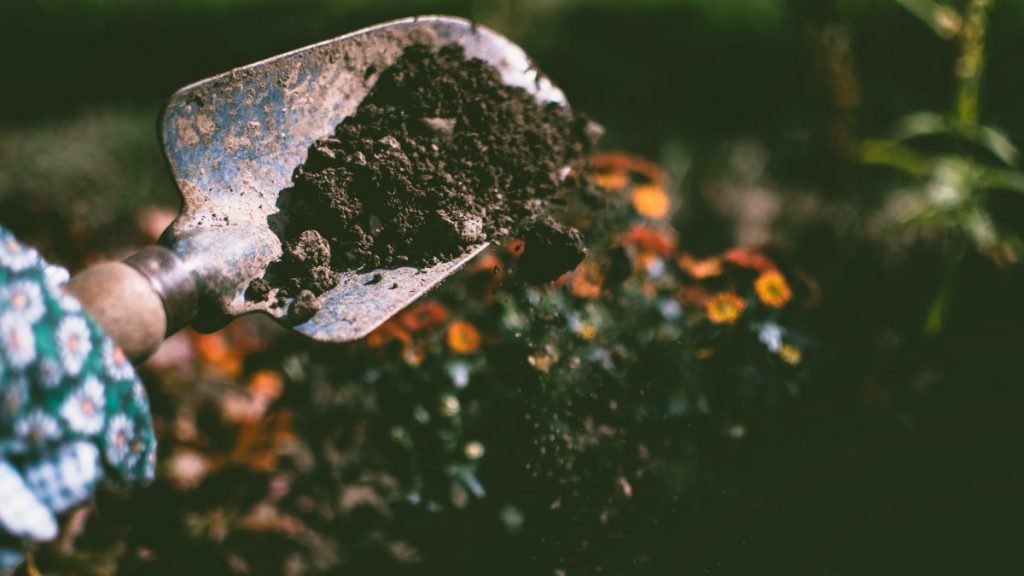When moving house or taking on a new plot, often the soil is in poor condition – depleted nutrients and lack of humus creating a poor growing environment. What to do to improve things and reinvigorate the soil.
Drainage
The first thing to do in a new garden is check how it copes in heavy rain. If there are lingering puddles it indicates either poor drainage, compacted soil or a hardpan under the surface.
Poor drainage can be difficult and may need some thought as to the general design of the garden or the construction of a soakaway to drain the excess water away. Compacted soil isn’t a major problem, digging or rotavating will open it up or even just forking to open it up in a similar way to spiking a lawn. Hardpans under the surface can be sorted the same way but being deeper means they’re harder work to break up.
Acidity
The next task is to check the acidity level with a pH test kit. They’re cheaply available from garden centres, DIY stores etc. There’s a couple of articles on lime on the site. Some plants prefer a quite acid soil but most vegetables and grass do best on soils near neutral as this makes the nutrients more available. Lime also helps to break up a heavy clay soil – as does gypsum
Soil pH and Its Effect on Your Garden
Manure and Compost
The best additives to bring a soil back to life and get it in good heart are compost and aged manure. Both of these will add the major nutrients to the soil but more importantly they will add humus and micro-nutrients. Far better than throwing handfuls of fertiliser about!
One clear indicator of exhausted soil is a lack of worms, within months of adding compost or manure you’ll notice a big improvement in worm numbers. They’ll be busily improving the soil sustainably for you and the more the merrier.
Adding aged manure or compost will not harm any plants although meadow wild flowers do prefer a poor soil, the condition they’ve evolved to grow in. Adding fresh manure however can cause problems as it’s too strong. If you have a choice, always get the oldest manure you can. Otherwise, put it in a pile and let nature do it’s work for a few months.
How much manure / compost to add?
There’s an easy answer to this, as much as you can. If supplies are limited, and they usually are, do a section of the plot each year. Aim for a minimum of a layer a couple of inches (50mm) thick at least, preferably double that initially.
How to add the manure?
Much depends on the existing state of the soil. With a light, fairly friable soil just laying the manure on the surface may be enough. The worms will mix it into the soil below given time. Personally, I’d fork it into the top six inches though even with a light soil.
With a compacted heavy soil, usually clay, I’m afraid it’s some hard work ahead. An initial double dig, adding the available manure into the trenches as you go will be the best method to quickly produce a good, deep growing medium
A Warning about Manure
Sometimes farmers use a selective herbicide on their pasture which has a nasty ability to linger in the dung and poison your plot. I’ve written about this many times over the years since the problem reared its ugly head. Please check out these articles before obtaining your manure. Aminopyralid.
Further Information
There’s a number of articles on the site about fertilisers, manures, green manures, compost and composting. See Composts & Fertilisers





that’s an interesting topic John because we have been trying hard to Reinvigorating or put some goodness back into our soil including our raised beds and open ground we use horse manure on our raised beds and have spread some straw on some of the open ground to plough in
the farmer who used to deliver loads of cattle manure to our allotments is selling up and we are yet to find another supplier who may be interested in suppling us
so I have turned to growing green manure but i don’t know if that’s going to be as good an alternative to using cattle manure if it is we will be sowing more green manure on a rotation basis year on year but as i said its a suck it and see thing and more info would be appreciated from those who use green manure
and i see you have incorporated composts & fertilizers [site] in your topic that i will take a look at and of cause if i remember you did have the luxury of all that lovely sheep manure delivered in spring you luck person your professional advise on using green manure would be most welcome if poss RW
There are quite a few articles on green manure you might find helpful, Rowland.
Green Manures
I’m in the process of getting a load of mixed horse and cow manure, but it will be fresh. Reading your article points, I would just like to understand more about the ‘few months’ before using fresh stuff. Can it be said that 4 months aged ought to be fine?
thanks for that info John most helpful
I had a corner of my plot that did not drain at all. I “encouraged” my son to dig down a little and it turned out that there was a concrete plate about 18″ down. There had been garages there earlier and people had just dumped a layer of gravel and spoil on top of that. It now drains a treat like everything else.